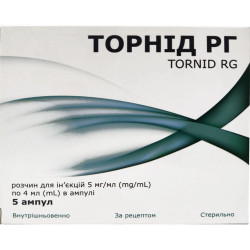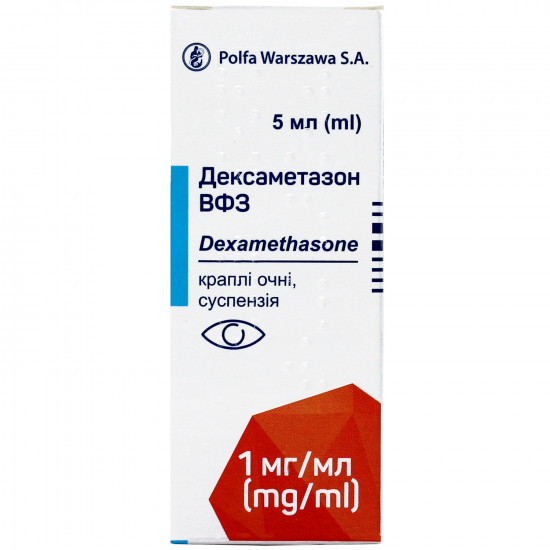
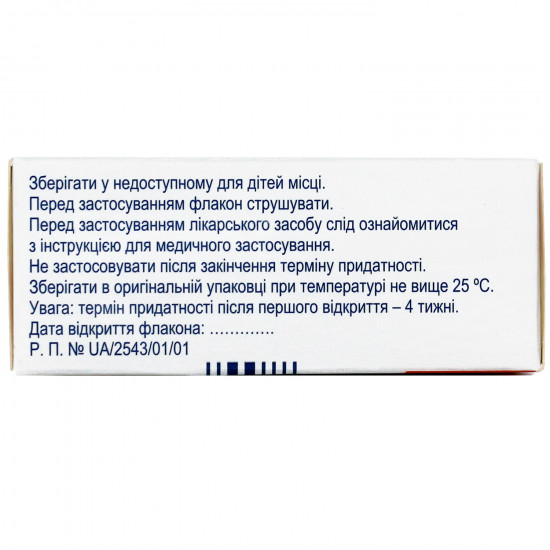

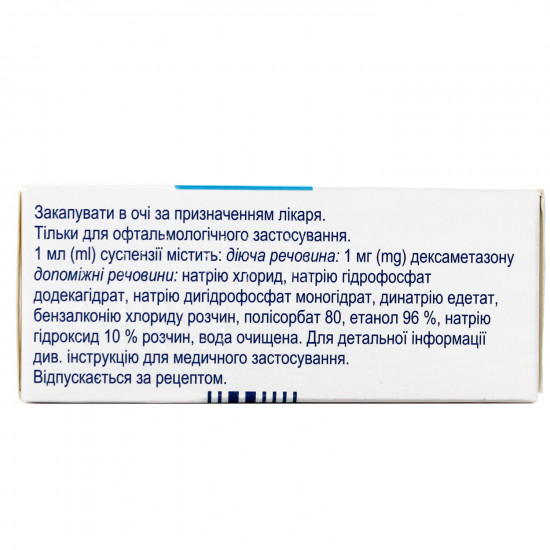
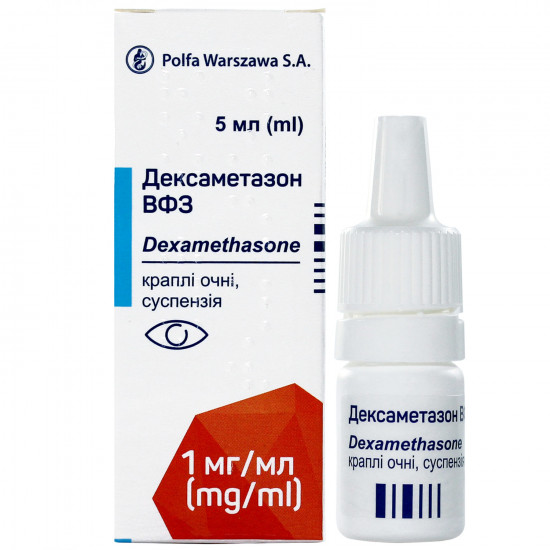
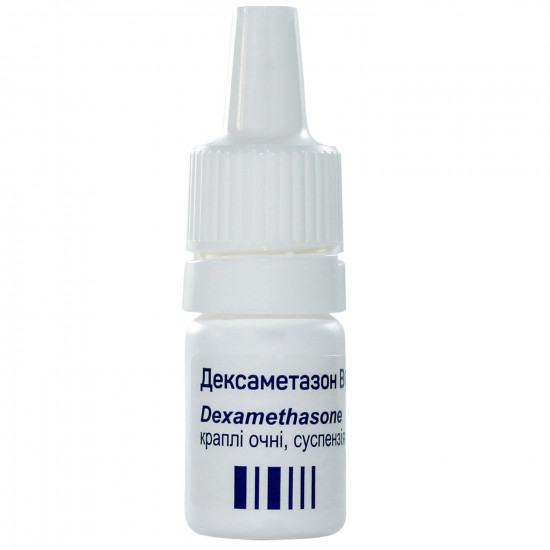






- Stock: In Stock
- Model: 179440
0% Customers recommend this product
-
5 Awesome0%
-
4 Great0%
-
3 Average0%
-
2 Bad0%
-
1 Poor0%
Reviews Over VFZ dexamethasone cap. eye. susp. 1mg/ml fl. 5 ml
- (0)
Total Reviews (0)
click here write review to add review for this product.
Report this review.
Description
Pharmacological properties
Pharmacodynamics. dexamethasone — synthetic gks with moderate activity, having anti-inflammatory, antiallergenic and immunosuppressive effect. influences all phases of inflammatory process. reduces permeability of blood vessels, suppresses migration of leukocytes, phagocytosis, release of kinin and antibody formation.
Pharmacokinetics. The dexamethasone entered into a conjunctival sac is soaked up in moisture of a chamber of the eye, a cornea, iridescent and vascular covers of an eye, a ciliary body, a retina. From a conjunctival sac the insignificant amount of active agent is soaked up therefore medicine has no systemic action.
Indication
Treatment of non-infectious inflammatory and allergic conditions of a conjunctiva, a cornea, a front segment of an eye, sensitive to steroids, including reactions of inflammation during the postoperative period.
Useto Apply
only in ophthalmology. before application to stir up a bottle!
Adult, including elderly people — at acute inflammatory process in a conjunctival sac are dug in on 1–2 drops by each 30–60 min. as initial therapy if the effect of treatment positive, then a dose is reduced up to 1–2 drops by each 2–4 h, it is possible to lower a dose to 1 drop 3–4 times a day if it is enough for inflammation process control. If the desirable result is not achieved for 3–4 days, additional system or subconjunctival therapy can be appointed.
At chronic inflammatory process in a conjunctival sac are dug in on 1–2 drops by each 3–6 h or are more often if it is necessary.
In an allergy or insignificant inflammation in a conjunctival sac are dug in on 1–2 drops by each 3–4 h before achievement of desirable effect.
not to stop therapy prematurely.
toAfter instillation recommends careful closing a century or lacrimonasal occlusion. It reduces system absorption of the medicament administered in an eye which reduces reliability of emergence of system side effects.
in case of the accompanying therapy with use of other local ophthalmologic medicines needs to observe an interval of 10-15 min. between their application.
Contraindication
Hypersensitivity to dexamethasone or to any of medicine components. the sharp superficial keratitis caused by herpes simplex; cow, chicken pox and other viral diseases of a cornea and conjunctiva; bacterial infection of an eye. the mikobakterialny infections of an eye caused, but which are not limited acid-resistant bacteria, such as mycobacterium tuberculosis, mycobacterium leprae or mycobacterium avium. fungus diseases of structures of an eye. a sharp purulent infection of an eye which, as well as other diseases caused by microorganisms can mask or amplify presence of corticosteroids. corticosteroids should not be applied after uncomplicated removal of a foreign body from an eye, in the presence of the infection or a trauma limited to a superficial epithelium of a cornea.
toSide effects
byAt use of medicine it was reported about side reactions which are classified as follows: very often (1/10), it is frequent (1/100 up to 1/10), infrequently (1/1000 up to 1/100), single (1/10,000 up to 1/1000), is very rare (1/10,000) or it is unknown (it is impossible to estimate the frequency of their emergence). within each group the side reactions are provided as reduction of their severity:
Research: infrequently — increase in intraocular pressure.
Disturbance from central nervous system: it is unknown — dizziness.
Ophthalmologic violations: often — thinning of a cornea, pain at the movement of an eyeball; infrequently — irritation of eyes; single — perforation of a cornea of an eye (visual disturbance, dacryagogue), glaucoma, changes in an optic nerve, a back subkapsulyarny cataract, disorder of sharpness and narrowing of fields of vision (indistinct vision, loss of sight), manifestations of an allergy with localization in eyes, an itch, a mydriasis; very seldom — a keratitis, a ptosis a century, discomfort and unusual feeling in eyes; it is unknown — a cornea erosion, coloring of a cornea, abnormal sight (zatumanennost), hyperaemia of eyes.
Infectious and parasitic diseases — an eye infection (aggravation or developing of consecutive infection).
Right after use of medicine the burning, pricking, insignificant hyperaemia of a conjunctiva, dacryagogue which disappear through 5–15 pages
Special instructions
can arise Drug is intended only for topical administration. at application not to touch a dropper for prevention of contamination of contents of a bottle. corticosteroids reduce resistance to a bacterial, viral or fungal infection that interferes it with identification. corticosteroids can mask clinical signs of manifestation of an infection, interfering with identification of inefficiency of antibiotics, or to suppress reactions of hypersensitivity to any of medicine components. at permanent formation of helcomas it is necessary to consider a possibility of a fungal infection at patients who were treated or treated by corticosteroids. in case of developing of a fungal infection the treatment by corticosteroids needs to be stopped.
Long therapy by corticosteroids can leadto emergence or acceleration of development of a cataract, increase in intraocular pressure in the patients predisposed to it, and in certain cases to cause glaucoma. Patients with diabetes are more inclined to such complications.
If medicament is used by patients with glaucoma, treatment needs to be limited up to 2 weeks except for cases when lengthening of treatment is justified (however constant control of intraocular pressure of the patient is necessary).
Corticosteroids which apply locally in an eye at frequent application a long time can slow down healing of wounds of a cornea.
during long-term treatment by dexamethasone needs to check a condition of a cornea the fluorescent test and to control intraocular pressure. In case of positive fluorescent test or the increased intraocular pressure of medicament treatment to stop.
Drug with care to appointto the patients who had a cornea disease with its thinning and scleras as there can be a perforation.
As medicine the benzalkoniya contains in quality of preservative chloride, it can cause irritation and also decolour soft contact lenses. Therefore during therapy medicine does not recommend to carry contact lenses what it is necessary to warn the patient about, or to inform on need to remove contact lenses before use of medicine and to wait 30 min. after burying before to dress them.
to Avoid contact of medicine with soft contact lenses.
not to stop therapy prematurely as the sudden termination of topical treatment by high doses of steroids can lead to a palindromia.
patients at system or local therapy by corticosteroids which were applied to treatment of other diseases had eye Herpes simplex. Use of corticosteroids during therapy of Herpes simplex, except for the epithelial keratitis caused by Herpes simplex for which treatment the corticosteroids are contraindicated demands extra care; periodic carrying out conjunctival biomicroscopy using a slit lamp is necessary. During the treatment of a stromal keratitis or a uveitis caused by Herpes simplex to use medicament with extra care and only in combination with anti-virus therapy, periodically carrying out biomicroscopy using a slit lamp.
Use during pregnancy and feeding by a breast. To use medicament for treatment during pregnancy only if the advantage for mother exceeds potential risk for a fruit.
not to apply dexamethasone during feeding by a breast as there is a probability of penetration of medicine into breast milk. In case of need medicament treatment feeding by a breast should be stopped.
Children. The efficiency and safety of use of medicine for children is not established.
Ability to influence speed of response at control of vehicles or work with other mechanisms. Dexamethasone does not affect ability to steer vehicles or to work with other mechanisms. However in connection with possible dacryagogue after burying it is not necessary to use medicament just before control of vehicles or work with the mechanical equipment until the sight is not restored.
Interaction
not to appoint dexamethasone along with medicines which are applied to treatment of glaucoma especially it is not necessary to apply such combination a long time and in high doses — it can lead to increase in intraocular pressure.
Prolonged use of medicine with anticholinergics (especially with atropine and chemicals of similar structure) causes increase in intraocular pressure.
Simultaneous use of dexamethasone with medicines which break accommodation of an eye or expand witha pupil, increases risk of increase in intraocular pressure (especially at the patients predisposed to development of the closed angle of filtration).
Use of contact lenses increases risk of infections.
Overdose
in case of overdose at topical administration to wash up surplus of medicine from an eye (eyes) warm water. accidental hit of medicine in a GIT does not cause heavy by-effects, it is recommended to accept enough liquid.
Storage conditions
B the place protected from light at a temperature not above 25 °C.
Specifications
| Characteristics | |
| Active ingredients | Dexamethasone |
| Amount of active ingredient | 1 mg/ml |
| Applicant | Warsaw Federal Law Polfa |
| Code of automatic telephone exchange | S01BA01 Dexamethasone |
| Interaction with food | It doesn't matter |
| Light sensitivity | Not sensitive |
| Market status | Generic-generic |
| Origin | Chemical |
| Prescription status | According to the prescription |
| Primary packing | bottle |
| Producer | WARSAW FEDERAL LAW POLFA OF A.T. |
| Quantity in packing | 5 ml |
| Release form | eye drops |
| Route of administration | Eye |
| Sign | Import |
| Storage temperature | from 5 °C to 25 °C |
| Trade name | Dexamethasone |

















